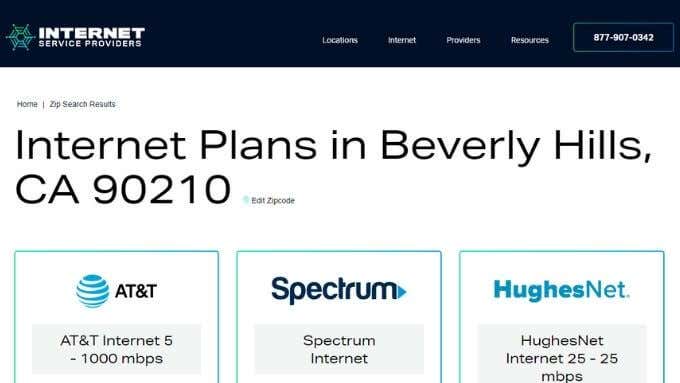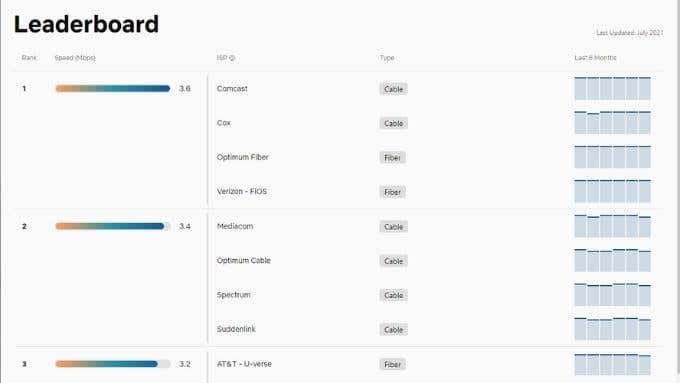What to Look For in an ISP
First, you must have a good idea of how to evaluate an ISP candidate. It’s not much help to find a list of local ISPs, and have no idea how to tell the good ones apart. There are four essential areas to evaluate, but for a more in-depth guide please read 7 Things To Bear In Mind When You Compare New Internet Providers.
Type of Connection
Internet service providers offer all sorts of internet connection types. The premiere choice at the moment is fiber optics internet. Still, you may also have the option to use copper-based DSL (Digital Subscriber Line), fixed wireless (e.g., 5G), or satellite internet (e.g., Starlink). Each of these connection types has its pros and cons, so be sure you understand them well before making a decision.
Shaping, Data Caps, and Fair Use Policies
Internet data plans come with rules that go beyond the basic marketing wording. For example, the advertisement might say “unlimited” data, but the fine print indicates that your connection speed will be reduced if you pass a certain threshold.“Shaping” is the practice of limiting certain kinds of internet traffic to much lower speeds than advertised. For example, video streaming and torrenting may only run at a fraction of the speed your connection can reach, while normal web browsing happens at full speed. Make sure you carefully read the data plan policy of an ISP before signing on with them.
Symmetrical vs. Asymmetrical Connections
Most users only care about the download speeds of their connection, but these days every user should be concerned with how quickly they can send data, not just receive it. With remote desktop, video conferencing, and cloud storage applications, you’ll benefit from having a fast upload speed.Most home internet connections are still asymmetrical. In other words, the download speed is much faster than the upload speed. You may see examples such as 100/10 or 50/25, with the second number representing upload bandwidth in megabits per second. With a symmetrical plan, both numbers are the same, so you can upload at precisely the same speed as you download.
Month-to-month vs. Contract Subscriptions
Some ISP plans are significantly cheaper because they lock you into a long-term contract. This can cost more in the long term since you can’t switch to other more affordable providers or plans when they start decreasing prices in the latter half of your contract period.Although month-to-month contracts may cost a little more monthly, they allow you to change ISP or change to other data plans at short notice. So if you’re no longer happy with your service, you aren’t locked in.
1. Use an ISP Directory Site
Now that we’ve had a crash-course overview of ISPs, the next step is to find the available ISPs in your area. The most efficient way to do this is by using an ISP directory site. These sites usually let you enter a ZIP code, or they can use your reported location or address. A prime example is ISP.com. If we enter the ZIP code for Beverly Hills, you’ll see a list of ISPs servicing that area. It’s a good idea to do the exact search on multiple ISP directory sites. That way, you can ensure that you see all potential ISPs and that one site doesn’t show a better offer than another. In addition to ISP.com, we also tried allconnect.com and inmyarea.com, but there are many options. We found different ISPs reported for the same ZIP code between these three sites, so take your time and be thorough.From there, you have to shortlist the ISPs that seem to have the best deals and then move on to researching how well they perform in real life.
2. Check Speed Ranking Sites
There are the speeds that an ISP claims it provides and then the speeds it offers. Internet speed ranking sites take the real-world test results submitted by users and aggregate them. This gives you a good idea of how well the service will perform.For example, using Ookla’s Speed Index, you can check what the average real-world speed is in the USA for different ISPs, in other states, and by city. Another helpful site is Netflix’s ISP speed index, where you can check how well various ISPs perform worldwide when it comes to Netflix traffic. Just keep in mind that shaped data plans limit different types of internet data to different speeds.
3. Check Social Media or Ask Your Neighbors
When it comes to the “last mile” of internet connectivity, it can be effective to ask around your immediate surroundings simply. If you’ve just moved into a new apartment complex or closed estate managed by a management body, there may be limited choices when it comes to ISP. Asking your neighbors or the manager of the housing organization could be the quickest way to find out what your options are and which ones are best.It’s not uncommon for people who live on the same block or in the same locality to form groups on social media or dedicated sites such as NextDoor. That makes these an excellent place to get tips on which ISPs are the best where you live from people who experienced the actual service.
Real-World Advertising
It’s also worth keeping an eye out in meatspace (that is, the real world) for posters, flyers, and other advertising around where you live. Sometimes small ISPs with excellent service advertise where they can assist. It’s easy to miss them on mainstream advertising platforms. If you keep your eyes and ears open while moving around your neighborhood, you’ve got a good chance of picking up on a great deal.

